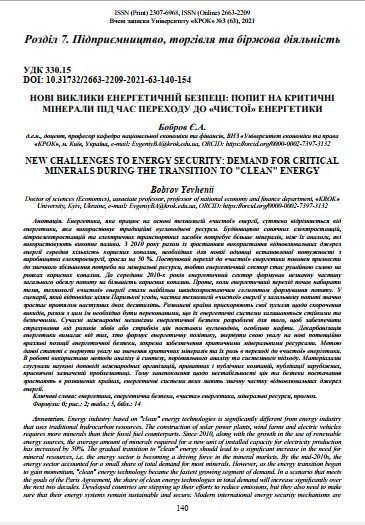NEW CHALLENGES TO ENERGY SECURITY: DEMAND FOR CRITICAL MINERALS DURING THE TRANSITION TO "CLEAN" ENERGY
DOI:
https://doi.org/10.31732/2663-2209-2021-63-140-154Keywords:
energy, energy security, , mineral resources, forecastAbstract
Energy industry based on "clean" energy technologies is significantly different from energy industry that uses traditional hydrocarbon resources. The construction of solar power plants, wind farms and electric vehicles requires more minerals than their fossil fuel counterparts. Since 2010, along with the growth in the use of renewable energy sources, the average amount of minerals required for a new unit of installed capacity for electricity production has increased by 50%. The gradual transition to "clean" energy should lead to a significant increase in the need for mineral resources, i.e. the energy sector is becoming a driving force in the mineral markets. By the mid-2010s, the energy sector accounted for a small share of total demand for most minerals. However, as the energy transition began to gain momentum, "clean" energy technology became the fastest growing segment of demand. In a scenario that meets the goals of the Paris Agreement, the share of clean energy technologies in total demand will increase significantly over the next two decades. Developed countries are stepping up their efforts to reduce emissions, but they also need to make sure that their energy systems remain sustainable and secure. Modern international energy security mechanisms are designed to insure against the risks of disruptions or spikes in the supply of hydrocarbons, especially oil. The decarbonisation of energy requires those who shape energy policy to pay attention to new potentially vulnerable positions in energy security, including the provision of critical mineral resources. The purpose of this article is to draw attention to the importance of critical minerals and their role in the transition to "clean" energy. The methods of analysis and synthesis, comparative analysis and system approach are used in the work. The materials were scientific reports of international organizations, private and public companies, foreign publications on this issue. Therefore, concerns about price volatility and security of supply are growing in developed countries, whose energy systems have a significant share of renewable energy sources.
Downloads
References
Paris Agreement. 2015. URL: https://unfccc.int/sites/default/files/english_paris_agreement.pdf
Final List of Critical Minerals 2018. Federal Register. URL: https://www.govinfo.gov/content/pkg/FR-2018-05-18/pdf/2018-10667.pdf
Critical Raw Materials Resilience: Charting a Path towards Greater Security and Sustainability. Communication from the Commission to the European Parliament, the Council, the European Economic and Social Committee and the Committee of the Regions. Brussels, 3.9.2020, COM (2020) 474 final. URL: https://ec.europa.eu/docsroom/documents/42849
Issues for Consideration in Formulating A New International Resource Strategy. Ministry of Economy, Trade and Industry, Government of Japan. Tokyo. 4.10.2019. URL: https://www.meti.go.jp/english/press/2020/0330_005.html
Moss, R. L. Tzimas, E. Kara, H. Willis, P. Kooroshy, J. (2011), Critical Metals in Strategic Energy Technologies: Assessing Rare Metals as Supply-Chain Bottlenecks in Low-Carbon Energy Technologies, EC JRC. 2011. doi: 10.2790/35716.
Ashby, M. F. Materials for low-carbon power, in materials and the environment. 2013. doi:10.1016/b978-0-12-385971-6.00012-9.
Mineral Commodity Summaries 2020. U.S. Geological Survey. URL: https://pubs.usgs.gov/periodicals/mcs2020/mcs2020.pdf
World Nuclear Power Reactors&Uranium Requirements. World Nuclear Organisation. URL: https://world-nuclear.org/information-library/facts-and-figures/world-nuclear-power-reactors-and-uranium-requireme.aspx
Global Scenarios for Demand and Supply Availability 2019-2040. World Nuclear Organisation. URL: https://world-nuclear.org/getmedia/b488c502-baf9-4142-8d12-42bab97593c3/nuclear-fuel-report-2019-expanded-summary-final.pdf.aspx
Renewable Capacity Statistics 2021. International Renewable Energy Agency. URL: https://www.irena.org/-/media/Files/IRENA/Agency/Publication/2021/Apr/IRENA_RE_Capacity_Statistics_2021.pdf
Global Renewables Outlook: Energy transformation 2050. International Renewable Energy Agency. URL: https://www.irena.org/publications/2020/Apr/Global-Renewables-Outlook-2020
Short-Term Energy Outlook. U.S. Energy Information Administration. URL: https://www.eia.gov/outlooks/steo/report/global_oil.php
Global EV Outlook 2021. International Energy Agency. URL: https://www.iea.org/reports/global-ev-outlook-2021
World Energy Outlook 2020. International Energy Agency. URL: https://www.iea.org/reports/world-energy-outlook-2020.



